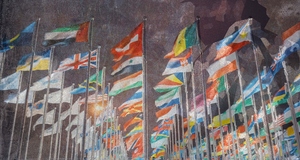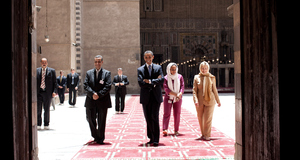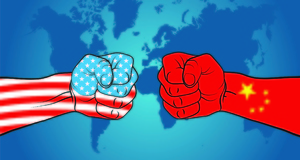Featured Article:Realism and Arab Nationalism: An Uneasy Partnership
By
2017, Vol. 9 No. 12 | pg. 1/1
IN THIS ARTICLE
KEYWORDS
The relationship between realism and nationalism is not clearly articulated in international relations literature. On one hand, realism and nationalism are viewed as contradictory forces, standing against one another as reason to emotion, reality to identity. On the other, nationalism and power politics are inherently intertwined; nationalism often significantly promotes the escalation of war, thus affecting the balance of power. In the context of the modern Middle East, the relationship between realism and nationalism is obfuscated even further as Arab nationalism, a neither particularistic nor singular strain of nationalism, framed through multiple identity discourses and transformations in the state system across time and space (Kramer 1993; Woods 2004). This essay examines the extent to which the history and role of Arab nationalism in the Middle East supports or contradicts a realist account of the region. Imprecise definitions and delineations of Arab nationalism make research on the topic more difficult (Mabry 2015, 54). Disagreement among Arabs themselves over how to define strains of Arab nationalism, such as Pan-Arab nationalism (‘qaymiyya’) and state-centric Arab nationalism (‘wataniyya’), also explains why much of the research on Arab nationalism is “discordant” (54). For these reasons, studies on Arab nationalism often rely on interpretations of the concept by different Arab nationalist leaders (54-55). In light of the conflicting terminology that surrounds the topic, this essay will discuss Arab nationalism of the ‘qaymiyya’ strain, the roots of which lie in linguistic revolution. As with all nationalisms, there are several strains of Arab nationalism based on different guiding principles (Kramer 1993; Bitar 2011, 52). According to Albert Hourani, among the three forms of nationalism—religious nationalism, geographic nationalism, linguistic nationalism—the latter is most applicable to the Middle East context (qtd. in Bitar 2011, 52). According to Hourani:
To Arab nationalist thinkers like Zakī Al-Arsūzī, race could not stand as a force for unification (Woods 2004). Sati’ Al-Husri, for instance, dismissed race as a foundation of an Arab nation, characterised by diverse groups of people with separate origins (Choueiri 2000, 122). To Al-Husri, the concept of race was not only an inaccurate means of describing Arab peoples, but would very well undermine Arab nationalism itself (Kramer 1993; Woods 2004) Other Arab nationalists considered the notion of a nationalism based on racial roots to be an imperialist mechanism for division (Kramer 1993; Woods 2004). Shaykh 'Abdullah al-'Alayili believed that conceptualising race as a foundation of nationalism reflected the desire of the state to pursue its own selfish interests (Woods 2004). Similarly, Michael 'Aflaq believed a nationalism based on racial unity was nothing more than the product of Western imperialist forces (Woods 2004). The Arab nationalists’ predilection of the linguistic form, thus, was a decision based a rejection of ethno-nationalism. To that end, Arab nationalism, a socially constructed nationalism based on elements of language and history, will define what is meant by ‘Arab nationalism’ for the remainder of this essay. To make sense of the relationship between realism and Arab nationalism, it is necessary to explore the background to which Arab nationalism emerges in the Middle East and then examine the ways in which it is incorporated into political thought across the region. This brief historical analysis sets the context for examining whether Arab nationalism can be rationalised accordingly to assumptions of realist theory, as set out by Kenneth Waltz, Hans Morgenthau and E.H. Carr, among others realist theorists. This paper will conclude by arguing that while realism cannot account for the ideological tenets of Arab nationalism, it is an adequate framework forf explaining the political reality of Arab nationalist thought. Roots of Arab NationalismThe intellectual roots of Arab nationalism can be traced back to the Arabic speaking populations of a weakening Ottoman Empire (Shlaim 2003; Grafton 2003, 91). Traditional wisdom on the formulation of national identity in the Middle East by historian George Antonius points to language as the foundational concept of Arab nationalism (Shlaim 2003). Antonius distinguishes the linguistic revival as a response to Turkification; after the 1909 Young Turk Revolution, the call to return of Standard Arabic to education and administration grew in popularity and intensity among Arab nationalist thinkers (Grafton 2003, 91; Suleiman 1994, 10). The promotion of the standardisation of the Arabic language across provinces of the Ottoman Empire took the form of a number of cultural societies, which aimed to popularise the use of Arabic among Arab schools and society. These societies, all formed between 1907 and 1913, included Al-Muntada Al-Adabi, Al-Arabiyya Al-Fata, Al-Ifsāh, Al-Ahd and Al-Nahda (Suleiman 1994, 8). The most active of these societies, Al-Nahda, went to great measures to formulate a number of policy statements in its constitution dedicated to the active promotion of the Arabic language, some of which included replacing Turkish numbers in backgammon with Arabic numbers and refusing to give alms unless beggars asked for in in Arabic (Suleiman 1994, 9). The promotion of Standard Arabic did not remain exclusive to small groups of cultural intellectual societies. In 1913, a group of Syrian and Lebanese Arab nationalist activists joined Ottoman authorities in an organised conference in Paris to demand Turkish be replaced with Arabic in schools (Grafton 2003, 91). Syrian classical linguist Sa’id Al-Afghānī illustrates the first two decades of the twentieth century in Syria by the emergence of locally-funded Arabic-language schools. The shift from symbolic to practical applicability of Arab nationalist ideals is perhaps most apparent in the classroom, where pupils were required to answer teachers in the classical ‘labbayka’ rather than the Turkish form, ‘afandim’; pupils speaking in Turkish were likewise subject to punishment by school administrators (Suleiman 1994, 9). Arabisation took form at the university level in 1919 when Damascus University’s law and medicine departments ado fpted Arabic as its official language of teaching. The decision to instill Arabic in the educational system can indeed be considered a political one: that the Faculty of Medicine in Damascus University became a pioneer in producing dictionaries of terms in Arabic from French and Turkish stood as proof that the Arabic language was just as sufficient as Turkish and Western languages (18). In this way, the promotion of Arabic was meant to counter a sense of national deficiency generated by feeling of “inferiority” in students who felt that their language was somehow inadequate (18). It is important to note that the for many Arab nationalist thinkers, Arabic was not the primary language. For instance, Sati’ Al-Husri’s primary language was Turkish. His linguistic transition to Standard Arabic followed the collapse of the Ottoman Empire, when many faced the dilemma of identity: were they Turks or Arabs (Tibi 1997,145-146)? To Al-Husri, the interaction between common language and common history formed the main tenets of Arab nationalism. He stated, “[Arabic language is] the most important non-material link between the individual and the other members of a social group” (qtd. in Tibi 1997, 145). Other nationalist theorists supported Al-Husri’s elevation of Arabic in Arab nationalist ideology. Nationalist cleric Shaykh Abdullah Al-'Alayili similarly called Arabic the unifying force of nationalism, stating “[the land of the Arabs] coincided with the historical and final expansion of the Arabic language” and that “the Arabisation process left behind a permanent imprint and a triumphant language” (qtd. in Woods 2004). As the promotion of Standard Arabic was also a means of transcending regional dialects that may render division among local populations (Suleiman 1994, 10), the Arabic language was a symbolic asset in the generation of an ‘Arab identity’, and in turn, an Arab nationalist ideology (Tibi 1997, 145-146). Al-Husri’s belief that an Arabic-speaking person is intrinsically an Arab (Mabry 2015, 54) illustrates his rejection of both notions of ‘the state’ and ‘common territory’ as basic elements of nationhood. The interdependence between the elevation of nationalism via Arabic and Islam as the dominant religion of the region is important for a discussion of Arab nationalism. Construction of this brand of social nationalism is based not only on language but also on a set of normative values to accommodate the multifaceted cultural nature of the Middle East (Woods 2004). To Fred Halliday, the very rise of Standard Arabic necessitated a close engagement with the Quran. Indeed, much of the rhetoric of secular Arab nationalism was taken from the Quranic lexicon, particularly words like umma (‘national community’), watan (‘homeland’) and risala (‘mission’) (Halliday 2013, 444). Even Christian Arabs arguably recognised the significance of Islam in the place of secular Arab nationalist ideology (Choueiri 2000, 163). For Michel Aflaq, Islam and Arab nationalism were two sides of the same coin as he considered Islam an inherent part of Arabs’ “innermost personality” (163). Qustantin Zurayk, another Christian Arab, similarly recognised Prophet Muhammad and Islam as “valuable historical heritages for Arabs of any faith” (Helms 1990, 23). Thus, Islam, like the Arabic language, was seen as a unifying feature of Arab nationalism. Indeed, among Arab nationalist thinkers, the cultural history of Islam was, like Standard Arabic, emphasised as a means of incorporating different forms of identities and accommodating different social groups in the Middle East (Kramer 1993). Realism and Nationalist IdeologyDoes nationalist ideology have a place in realism? In many ways, an understanding of whether Arab nationalism can support a realist account of the region needs to first examine the basic elements which make up each theory. An examination of Kenneth Waltz’s international political theoretical framework reveals the centrality of power in the international system. According to Waltz, power is able to provide states with four necessary elements of survival in the international system:
An emphasis on power is supplanted by Waltz with a means of measuring it. Waltz’s list of elements of state power includes those which can be measured empirically to other states. Natural resources, strong economy, powerful military, and stable political institutions are among the elements Waltz recognises; ideology of any form is explicitly excluded (97-98). Waltz’s dismissal of ideology or national identity is a consistent theme throughout realism theory. Machiavelli, in his general description of realism, determines power a more important determinant of political events than ideology. Morgenthau similarly undermines the role of ideology in understanding state relations in his ‘Principles of Political Realism’. In Morgenthau’s account, realism fundamentally chooses to ignore the intellectual and moral bedrock of the statesman, the concept of interests vis-à-vis power infuses rational explanation and calculation into the realm of international relations in a way which works to guard the theory against the significance of understanding underlying motives and ideology (Morgenthau 4-15). The realist tendency to focus on state power limits the role of national ideology and identity as means of altering the balance of power. Likewise, and perhaps most telling, E.H. Carr’s seminal text, The Twenty Years’ Crisis, presents a polemical attack against inter-war utopian thought, which, according to Carr, was characterised by “visionary projects” calling for “national solidarity” (Carr 2016). To Carr, ideological principles are not principles at all, but façades which allow states to pursue their national interests. Therefore, realism’s focus on rational theories to explain international phenomenon presents a theoretical predisposition to underestimate or ultimately reject the role of nationalist ideology, thus suggesting a fundamental disparity between Arab nationalism and realism. Conflicting Conceptions of ‘The State’It is difficult to then reconcile Al-Husri’s rejection of ‘the state’ as a necessary condition for Arab nationalism with a realist account. Considering that the state is the most dominant unit of analysis in realism, the state would also be the main unit of analysis in a realist account of nationalism. Al-Husri’s rejection of the nation-state as a necessary condition for his formulation of Arab nationalism presents a distinct account of identity that is at odds with realism. While realism defines identity in terms of the state, Arab nationalism defines the state in terms of socially constructed identity, vis-à-vis a common language and history. The elevation of the Arabic language and cultural Islam as identities was meant to transcend geographical barriers across the region. The result: a latent consciousness among Arabs which constrained state-centric behaviour. The rhetoric of Arab nationalist ideology does not emphasise state sovereignty or the centrality of autonomous states so much as it did trans-regional unification. It is, therefore, the inherent nature of the Arab nationalist ideology which reveals a fundamental contradiction with realist theory. Unlike nationalism in Europe, Arab nationalism of the qaumi strain is not exclusive to a particular nation-state; the ‘nation’ was meant to incorporate all Arabic-speakers, who were thus Arabs, while ‘states’ were merely viewed as parts of that whole (Rubin 1991, 535). The state was not of fundamental importance. The universalistic nature of Arab nationalism (Kramer 1993) indeed stands against the exclusive nature of realism. Coming to Terms With Anarchy and SovereigntyThe relationship between the centrality of the nation-state and concepts of anarchy and sovereignty is critical in realist theory (Waltz 1979; Morgenthau). According to realist theorists like Waltz, the anarchical system fosters antagonistic conditions in which there is no central world government, setting nation-states as the most important sovereign actors in a self-help system (Carr 2016). Arab nationalism, however, dictates that the interests of the broader Arab community, the ‘Arab nation’, supersedes the self-serving interests of individual Arab states (Halliday 2013, 235). According to tenets of the ideology, the elevation of Standard Arabic, with its enduring relationship to Islam, in particular, represents a solidarity among Arabs across the region. Transnational recognition of a common Islamic heritage and common language, which were meant to overcome conflicting identities and competing tribal, ethnic and religious interests, would achieve a national consciousness of political unity and cooperation. Therefore, the implications of Arabic language and Islam as unifying forces in Arab nationalism—allegiance and loyalty to the common Arab nation—contradict basic realist assumptions of anarchy and sovereignty. A testament to its ideological character, Arab nationalism stresses the construction of a (symbolic) single sovereign entity which “ought to have a common government” (Goldschmidt, Jr. 1979, 181-182). Hence two fundamental beliefs of Arab nationalism which contradict realism: (1) the reality of trans-national cooperation over chaos and (2) the fallacy of state sovereignty. Arab nationalism and realism possess irreconcilably different understandings of anarchy and sovereignty. The Gap Between Ideology and RealityDespite a number of fundamental disparities between Arab nationalism and realism, a realist examination is able to reveal a sizable gap between ideology and reality in the role of Arab nationalism in the Middle East. Arab nationalist solidarity envisaged a community of individual Arabs linked through transnational, rather than intergovernmental, institutions. This belief materialises via the formation of a number of short-lived Arab Federations, including the union between Jordan and Iraq (1958); the United Arab Republic (1958), which involved Egypt and Syria; and the Federation of Arab Republics (1972), which involved Egypt, Libya and Syria (Macdonald 1965, 229). Likewise, the Arab League Collective Security Pact establishes inter-Arab cooperation over anarchy as the definitive guiding force. Insofar it acknowledges that states establish institutions that may encourage cooperation, a constructivist framework may thus better account for Pan-Arab nationalism than realism. Nonetheless, an empirical examination of these institutions exposes a number of realist assumptions in application; particularly the notion that states pursue their own interests at the expense of other states’ interests. A realist analysis of Arab nationalism in practice reveals realpolitik and the pursuit of national interests by Arab state leaders. In many cases, the political reality of Middle Eastern states in the twentieth century reveals that sweeping nationalist calls for leaders to pursue the interests of the Arab nation over the interests of their separate states being put aside (Macdonald 1965, 228-230). Indeed, when Arab leaders perceived their individual states’ sovereignty to be at risk, they would consistently sacrifice the survival of any notion of Arab unity for collective national security (229). At the same time, many institutions designed under the banner of promoting Arab nationalism were, in reality, superficially created to maximise a state’s individual interests or the personal interests of a leader or regime (229). A cursory examination of the United Arab Republic reveals realist assumptions at work. Egypt’s attempt to maximise its breadth of power in the region. Egypt’s political control of the Republic left little room for Syria to provide input regarding the affairs of the union. Military leaders and other leading figures from the Syrian were strategically transferred to Cairo by Nasser’s regime as a means of ensuring they were isolated from their power bases. Egypt essentially sought to control Syria like a colony, as it took control of Syria’s security forces and bureaucracy. Despite initial commitments, Iraq then refused to join the Republic. Iraq’s decision to refuse U.A.R. membership reflects a primacy of national interests; to the detriment of Arab nationalist ideals, Iraq deemed it better to ensure its sovereignty after witnessing Egypt’s behaviour toward Syria (Macdonald 1965, 229). In this case, the national interest of the Iraqi state trumped Arab nationalist ideology. Though sympathetic to Pan-Arab nationalism, Iraq’s actions of not joining the U.A.R. shows a policy towards self-determination as it sought to protect itself against foreign intervention by Nasser’s regime. This claim connects to the description of realism as set out by Wayman and Diehl’s, who state that state scepticism towards transnational ideals will often replace or transcend nationalism (Wayman and Diehl 1994, 8). Egypt’s self-interested behaviour supports this claim as its conduct reinforces the role of power politics as a fundamental feature of Middle Eastern politics, thus supporting a realist account of the region. Nationalist Arab regimes have often hijacked nationalist rhetoric to pursue power politics. According to Robert Macdonald, the signing of the Arab League Collective Security Pact “was an astute political gesture designed to convey the impression of Arab solidarity in the face of aggression” (MacDonald 1965, 229). That Arab leaders pursued balance of power politics under the guise of calls for Arab solidarity reveals a primacy of power over idealist nationalist rhetoric, thus supporting a realist account of Arab nationalism. The gap between ideology and reality is further unravelled when we consider that Arab nationalism was installed at the behest of the domestic government. Similarly, Margaret Law shows that King Faisal, among other leaders, was “motivated by personal or dynastic ambitions…rather than for more ideological reasons” to pursue Pan-Arab nationalism as policy (Law 1996, 125). Finally, Arab nationalism is often considered to be a balancing mechanism against Western power (Nugent et. al. 2016, 8) Although Bernard Lewis writes, “there is no lack of individual policies and actions, pursued and taken by individual Western governments that have aroused the passionate anger of Middle Eastern and other Islamic peoples,” Nugent, Masoud and Jamal believe the occupation of Palestine a geopolitical form of Western dominance in the region (qtd. in Nugent et. al. 2016, 5). Solidarity as characterised by common language and history is often interpreted as defensive retreats into linguistic and ethnic identity (Nugent et. al. 2016, 2). According to Nugent, Masoud and Jamal, early twentieth-century Arab nationalists were driven by a “desire to counter the spread of Western culture with their own, indigenous, Arab variant” (6). A root motive behind these ambitions was the emergence of a disquieting realisation among a number of Arab intellectuals who recognised that Arab societies were significantly weaker than those of the West. While many thinkers blamed imperialist forces, many suggested an inherent weakness in Arab culture and society. Consider that in response to a 1930s article entitled, “Why are Muslims Lagging Behind the Christians,” Arab nationalist Adil Arslan concluded that Arabs must unite under a single government (Rubin 1991, 535). Under these considerations, balance of power politics is able to provide a more coherent account of Arab nationalism than constructivist notions of cooperation. While not wholly irreconcilable, realism and Arab nationalism qualify a shaky relationship. Arab nationalism’s non-particularistic nature denies an account of the primacy of the state. Consequently, realism’s rational ontology rejects the ideological foundations of Arab nationalism. Nonetheless, Arab nationalism has often reinforced the realist assumption that states must balance against states whom they share an ideological affinity. To that end, the history and role of Arab nationalism in the Middle East is able to support an account of realism, insofar that the ideological foundations of Arab nationalism break down. ReferencesBitar, S. I. (2011). “Language, Identity, and Arab Nationalism: Case Study of Palestine.” Journal of Middle Eastern and Islamic Studies (in Asia) 5(4), 48-64. Carr, E.H. (2016). The Twenty Years’ Crisis, 1919-1939. London: Palgrave Macmillan. Choueiri, Y.M. (2000). Arab Nationalism: A History: Nation and State in the Arab World. Oxford, England: Blackwell Publishing. Goldschmidt A. (1979). ‘The Roots of Arab Bitterness.’ A Concise History of the Middle East, 181-197. Boulder, Colorado: Westview Press. Grafton, D. (2003). The Christians of Lebanon: Political Rights in Islamic Law. London: Tauris Academic Studies. Halliday, F. (2013). “Nationalism in the Arab World Since 1945.” In The Oxford Handbook of the History of Nationalism. Oxford, England: Oxford University Press. Helms, C. M. (1990).Arabism and Islam: Stateless Nations and Nationless. Collindale, Pennsylvania: Diane Publishing Company. Kramer, M. (1993). “Arab Nationalism: Mistaken Identity.” Daedalus, 171-206. Law, M. (1996). ‘Nationalism and Middle Eastern Identities.’ Identities in International Relations. Palgrave Macmillan, 118-134. Mabry, T. (2015). Nationalism, Language, and Muslim Exceptionalism. Philadelphia: University of Pennsylvania Press.. MacDonald, R. W. (1965) The League of Arab States: A Study in Dynamics of Regional Organization. Princeton: Princeton University Press. Morgenthau, H. J. (1978). Politics Among Nations. The Struggle for Power and Peace, 5th ed, revised. New York City: Alfred A. Knopf. Nugent, E., T. Masoud and A. Jamal (2016). ‘Arab Responses to Western Hegemony: Experimental Evidence from Egypt.’ Journal of Conflict Resolution, 1-35. Rubin, B. (1991). ‘Pan-Arab Nationalism: The Ideological Dream as Compelling Force.’ Journal of Contemporary History 26(3), 535-551. Shlaim, A. (2003). “The Rise and Fall of Arab Nationalism.” Review of Arab Nationalism in the Twentieth Century: From Triumph to Despair, by Adeed Dawisha. The Guardian. 28 March 2003. Suleiman, Y. (1994). Arabic Sociolinguistics: Issues and Perspectives. London: Curzon Press Tibi, B. (1997). Arab Nationalism: Between Islam and the Nation-State. New York City: St. Martin’s Press. Waltz, K. (1979) Theory of International Politics. Reading, MA: Longman Higher Education. Wayman, F.W. and P.F. (1994) Diehl. Reconstructing Realpolitik. Ann Arbor: University of Michigan Press. Woods, N. (2004). “Arab Nationalism and Political Culture.” https://www.mtholyoke.edu/~nmwoods/arab.htm Suggested Reading from Inquiries Journal
Inquiries Journal provides undergraduate and graduate students around the world a platform for the wide dissemination of academic work over a range of core disciplines. Representing the work of students from hundreds of institutions around the globe, Inquiries Journal's large database of academic articles is completely free. Learn more | Blog | Submit Latest in Political Science |


















